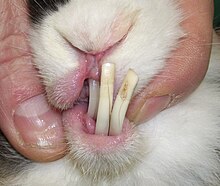Pike bit

The term pike bit describes a lower jaw protruding beyond the upper jaw . The terms brachygnathia superior and prognathia inferior are used synonymously .
As a result of the constant regrowth of the incisor teeth , which is typical for rabbits and rodents , the presence of a pike's bite can trigger serious secondary diseases.
Emergence
There are two causes of pike bite: primary and secondary malocclusion . Malocclusion is when the contact points ( occlusion ) of the upper and lower teeth no longer match the natural conditions. Primary or congenital malocclusion occurs particularly in dwarf rabbits. In addition to the indisputable genetic predisposition for this disorder, influences of domestication are also ascribed a role. One theory assumes that in captivity, the brain volume decreases due to the lower intelligence of the animals necessary for survival. A smaller brain volume requires a smaller skull. While this shrinks due to breeding, the dimensions of the lower jaw remain largely unchanged, whereby it ultimately grows forward beyond the facial skull.
All teeth in rabbits , guinea pigs and chinchillas as well as the incisor teeth of rodents belong to the so-called rootless teeth . Rootless teeth grow throughout life. So that these teeth do not become too long, each tooth needs a counterpart ( antagonist ) on which it can rub off. This is no longer the case with a pike bite, so that the incisors often grow unhindered in length . Most often, however, changes in the teeth of rabbits are caused by inappropriate feeding. If the constantly growing teeth do not wear enough due to the feeding of high-energy feed (colored feed, grain feed), there is insufficient abrasion and changes in the teeth with malocclusion. This initially leads to an elongation of the tooth crowns in the area of the molars , which secondarily leads to incorrect growth of the incisors.
Secondary diseases
From a certain length of the teeth the feeding of the animals is mechanically hindered. In addition to being emaciated as a result of insufficient nutrient absorption, the digestive tract, which is dependent on constant feed, is often permanently damaged by secondary diseases ( dysbacteria , coccidiosis ). Tooth tips piercing the oral mucosa also reduce food intake due to the pain caused . In addition, infections can settle in the mouth area, which can lead to suppuration of the tooth sockets and the lower jaw , especially in rabbits .
prophylaxis
Rabbits are herbivores and are naturally geared towards chewing and utilizing fiber-rich plants. Concentrated feed is only used for fattening; the rabbit does not need any energy-rich ( high-carbohydrate ) feed, because this disrupts proper digestion (overgrowth of the intestine with yeast , intestinal mycosis ), which can lead to diarrhea .
In addition to the constant supply of fiber-rich food ( hay ), which requires intensive chewing and thus promotes tooth wear, the teeth of all rabbits and rodents should be checked regularly by a veterinarian. The often recommended cuts can make the problem worse if not done properly. Shortening excessively long teeth is symptomatic relief and not a cause-oriented treatment. In the case of overgrowth of teeth, radical feeding corrections and regular veterinary checks are always necessary.
correction
If the teeth are only slightly overgrowth, a correction can be achieved over a longer period of time by special grinding after shortening the teeth. Attention must also be paid to correcting the molar extensions that are usually present. However, it can only be used to treat secondary occlusal disorders at a very early stage.
In the case of pronounced primary or secondary pike bite, the incisors have no function and can no longer perform their task. Here is an extraction advisable at a loosening rotation or suppuration it is imperative. Regularly shortening the incisors with a diamond disc is no longer recommended because of the risk of injury to the tooth cavity and thus inflammation . Shortening with pliers is a treatment error because of the inevitably occurring tooth fractures .
See also
literature
- Estella Böhmer: Dentistry in rabbits and rodents: textbook and atlas. Schattauer, Stuttgart 2010.
Individual evidence
- ↑ a b c Stefan Gabriel: Extraction of the incisors in rabbits . In: kleintier specifically Volume 17, 2014, No. 1, pp. 13-19. doi : 10.1055 / s-0033-1361568

